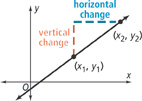2-3 Linear Functions and Slope-Intercept Form
Objectives
To graph linear equations
To write equations of lines
 Lesson Vocabulary
Lesson Vocabulary
- slope
- linear function
- linear equation
- y-intercept
- x-intercept
- slope-intercept form
You can describe movement in a coordinate plane by describing how far you need to move vertically and how far you need to move horizontally to get from one point to another point.
Essential Understanding Consider a nonvertical line in the coordinate plane. If you move from any point on the line to any other point on the line, the ratio of the vertical change to the horizontal change is constant. That constant ratio is the slope of the line.
The slope of a nonvertical line is the ratio of the vertical change to the horizontal change between two points. You can calculate slope by finding the ratio of the difference in the y-coordinates to the difference in the x-coordinates for any two points on the line.

Take Note Key Concept: Slope
The slope of a nonvertical line through points

Table of Contents
- 5-1 Polynomial Functions
- 5-2 Polynomials, Linear Factors, and Zeros
- 5-3 Solving Polynomial Equations
- 5-4 Dividing Polynomials
- 5-5 Theorems About Roots of Polynomial Equations
- 5-6 The Fundamental Theorem of Algebra
- 5-7 The Binomial Theorem
- 5-8 Polynomial Models in the Real World
- 5-9 Transforming Polynomial Functions





